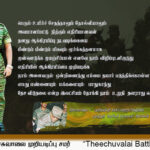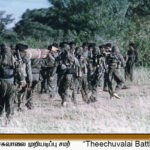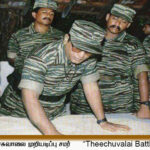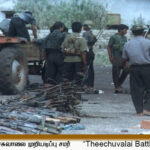

Tiger’s war movement and political movement

The armed liberation struggle has two bases, war and politics. The two bases are intertwined. Here the outcome of the battlefield will determine the solution in the political arena. This post is the best example the record of a fight.
There are two more reasons for writing this post. Unless the Tamil community learns the basics of war, they will not be able to fully understand the LTTE’s moves and the reason behind the movement. Therefore, in the eyes of the Tamil community, there is a danger of disappearing from history with the single memory of ‘something war happened’.
Those two reasons are to pass on the LTTE’s armed struggle to the next generation as possible and to accustom the Tamil community to a political approach to the war. Those two reasons waged the heroic and moral struggle of the twentieth century.
I have now given below the best example of that war, the reasons for the war, and its political effect. The name of the battle was “Theechuvalai Battle”. It took place from April 24-27, 2001. The field conditions before this battle should be mentioned.
Field status
At the end of April 2000, the Elephant Pass Military Complex (EPMC) fell to the LTTE. Even months before the fall, US military experts visited and confirmed that it was an “impregnable” military base.
It is then history that the LTTE carried out the largest landing by a non-state military force in the history of world warfare and captured the so-called ‘impregnable’ Elephant Base.
The important significance of the Elephant Pass
Jaffna’s Elephant Base is essential for the Sri Lankan military to control the country. It is a strategically important military base. To lift the LTTE barricade on Jaffna the Sri Lankan military is compelled to grab the Elephant Pass Base.
In the midst of this, the LTTE declared a month-long unilateral ceasefire from December 24, 2000, in an effort to “create an environment for peace.” This lasted until April 24th. Exactly four months. There is a background to this as well.
Norway had just begun peace talks with the LTTE. It is likely that a plan to declare a ceasefire with the LTTE in good faith would have come through Norway. At the same time, the LTTE wanted to use the ceasefire as a bargaining chip. Using it as a bargaining chip, to transform itself into a political solution with the recognition of the world order.
Indeed, this ceasefire will only militarily affect the LTTE. I will explain how to do that later. However, the LTTE had to make the move in recognition of the world order for a political solution.
What I described above is the field situation that preceded the ‘Theechuvalai Battle’.
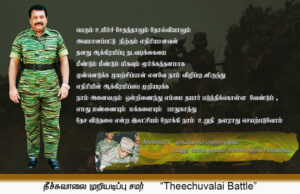 Exactly on April 24th, 2001, the Sri Lankan Army launched Operation Agni Keela (“Theechuvalai Battle”) on LTTE front lines in an attempt to capture the Elephant Pass.
Exactly on April 24th, 2001, the Sri Lankan Army launched Operation Agni Keela (“Theechuvalai Battle”) on LTTE front lines in an attempt to capture the Elephant Pass.
No more burial-related analysis of this military operation.
The terrain where this battle took place is narrower than the previously mentioned. In this military operation, Sri Lanka deployed 52, 53, 55 divisions of high combat capability with special training and preparations during the four-month ceasefire period. As well as all its military resources.
I will now explain why this LTTE ceasefire will militarily affect them.
This gave the Sri Lankan military the opportunity to concentrate its military resources (heavy concentration).
It gave them time to purchase new lethal weapon systems and prepare battalions.
What would have happened without the ceasefire?
The LTTE has continued to launch offensive attacks on other strategic positions to prevent the Sri Lankan military from amassing resources to capture the Elephant Pass. This would have forced the Sri Lankan military to keep troops in those strategic positions (distracting force deployments).
It is a war tactic that forces the enemy to spread widely and keep their position thin. Similarly, the Sri Lankan military is not going to have time. During these four months, no counter-offensive operations were carried out by the LTTE. They resorted to self-restrained defensive tactics.
However, the Sri Lankan army was attacking as usual. In these four months alone, the Sri Lankan military has killed 160 LTTE cadres and wounded 400 others.
Sri Lanka gained such a military advantage during the four-month ceasefire. That is why there is a possibility that this ceasefire plan may be incorporated into the LTTE through Norway in the guise of a world order ‘creating a congenial atmosphere conducive for talks’.
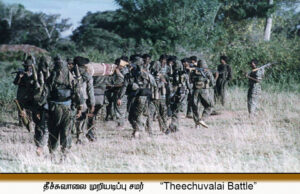 What happened in the war?
What happened in the war?
On April 24th, about 15,000 Sri Lankan soldiers began advancing into that narrow neck with unprecedented firing support (supported by heavy artillery, multi-barrel rocket fire and aerial and naval bombardment). The attack began at the LTTE’s forward positions of Kilaali, Eluthumadduva, and Nagerkovil. (Picture below. You can see how narrow this area is.)
Three days later, more than 400 Sri Lankan soldiers were killed and more than 2,000 wounded and they gave up the operation “Theechivalai Battle” and retreated. I have given below what General Theepan, who led the Breaking Battle, had to say about what happened within this battle.
I have also attached below the article written by Taraki Sivaram, the only war researcher in the Tamil community, about the war tactics used by the LTTE during the firefight.
After this successful LTTE firefight, the world realized that the LTTE had reached a forceful balance with the Sri Lankan military.
The reason is that there are two very basic factors that determine the success of the war.
- Number of troops
- The modernity of weapons and its technology and quantity and fire power.
Sinhalese make up 72% of Sri Lanka’s population. 12% is Sri Lankan Tamils. The MILITARY PARTICIPATION RATIO (MPR) will be commensurate with the population. At any point, the Sri Lankan military will be many times larger than the LTTE.
The Government of Sri Lanka is a state power recognized by the World Order. The LTTE is a non-state military force. Heavy weapons (tanks, artillery, helicopters, war planes) that can be purchased by a state power cannot be obtained by a non-state actor.
Therefore, a non-state actor can never achieve a force balance with a state power if approached through physical factors. However, in Sri Lanka the LTTE has reached a balance of strength.
In his article, Taraki Sivaram would have described the equations of Sri Lanka’s force balance. I leave it as it is.
“The military balance of power between the two countries cannot be estimated solely on the basis of the number of their artillery and troops,” he said. How they are arranged towards the enemy is also an important basis for exploring the force balance.
Large areas of LTTE control are located between Muhamalai and Omanthai in the north and south, and between the east and west coasts of Mullaithivu and Mannar. Surrounding it are the 51st, 52nd and 54th Divisions of the Sri Lanka Army in the north and a section of the 55th in the south and a division of the 21st, 56th and 22nd Divisions from Mannar to Manalaru. In addition to these Divisions there are several Divisions such as artillery, armored vehicles and supplies. Of these, 53 Divisions face north.
There are 22 Divisions in Thirumalai, south of the sand dunes in the east, 23 Divisions in Batticaloa north and Minneriya in the background, and more recently 55 Divisions.
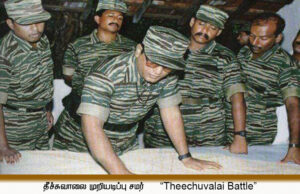 What do you understand when you look at this? That is, the fact that the Sri Lankan government has organized seven of its nine deployment Divisions towards LTTE-held territory in the north is easily understood by anyone who knows the basics.
What do you understand when you look at this? That is, the fact that the Sri Lankan government has organized seven of its nine deployment Divisions towards LTTE-held territory in the north is easily understood by anyone who knows the basics.
What is the reason for this? In April 2001, the Sri Lankan Army mobilized its forces in the north and launched a firefight from Muhamalai to Pallai. While defeating this, the LTTE was strong enough to prevent Sri Lankan troops from launching another offensive at the same time from any other point in the north.
This shows that there is a balance of power between the two sides in the north. This is due to the fact that the LTTE had a force equal to seven and a half Divisions of the Sri Lankan forces (55 Divisions were completely north at the time).
In other words, the failure of “Operation Theechuvalai Battle” made it very clear that the LTTE had a strength in the Vanni equal to that of 83 percent of the Sri Lankan forces. This was most clearly realized by Indian, British and American researchers.
With the fall of the Katunayake Air Force Base, it became very clear to the countries behind the Sri Lankan government that the military balance thus emerging in Sri Lanka was slipping.
After April 2001, the Sri Lankan government and its allies were forced to maintain this balance of power on the LTTE’s side.
They thought that if Sri Lanka’s military balance fell to the LTTE, the island’s military management would fall into their hands and the Sri Lankan government would be cut off from doing what it set out to do.
In addition, the countries realized that they could not directly or indirectly control some of the LTTE’s military resources in the balance of power. Things like how many artillery the LTTE has, how many Divisions it has, how many warships it has are all about symmetrical forces.
With these it is easier to predict the balance. However, the LTTE’s Black Tiger Force and the force attacking of Colombo are seen to be asymmetrical and therefore inaccurate.
For example, you can calculate how many times cannon can fire. However, it is not possible to measure the impact of a Black Tiger Team.
Therefore, the immensity of the current military balance between the Sri Lankan government and the LTTE in Sri Lanka and the imminent strength of the LTTE in attacking Colombo is a source of fear to foreigners. That is why they are trying to keep the LTTE permanently wrapped up in a coalition of negotiators.
Thus, the balance of power in Sri Lanka was restored with this fire-fighting battle. Three months later, with the attack on the Katunayake Air Base, the force began to lean towards the LTTE. The ceasefire agreement is a plan drawn up by the world order in order to allow time for the Sri Lankan military to tilt this balance of power.
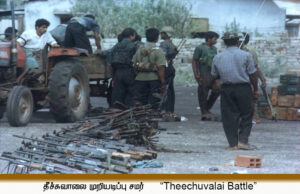 If you look closely, the four-month ceasefire mentioned above was designed to give the Sri Lankan military a military advantage. The four-year-old ceasefire agreement then served the same purpose.
If you look closely, the four-month ceasefire mentioned above was designed to give the Sri Lankan military a military advantage. The four-year-old ceasefire agreement then served the same purpose.
Just a single fight. However, behind that single battle are so many bourgeois, royal tactical moves. In my previous posts I have explained how great powers like the United States and China divide their strategies by targeting militarily advantageous positions.
Victory on the battlefield must be transformed into a solution in the political arena. That requires negotiations. However, the problem here is that the Tamil community thinks that “all peace talks are towards a political solution.” The reason for this discrepancy is that the Tamil community has no vision at all about the war movement.
Jeyakanth
Click below for more articles
thissovalai
“Theechuvalai Battle”
